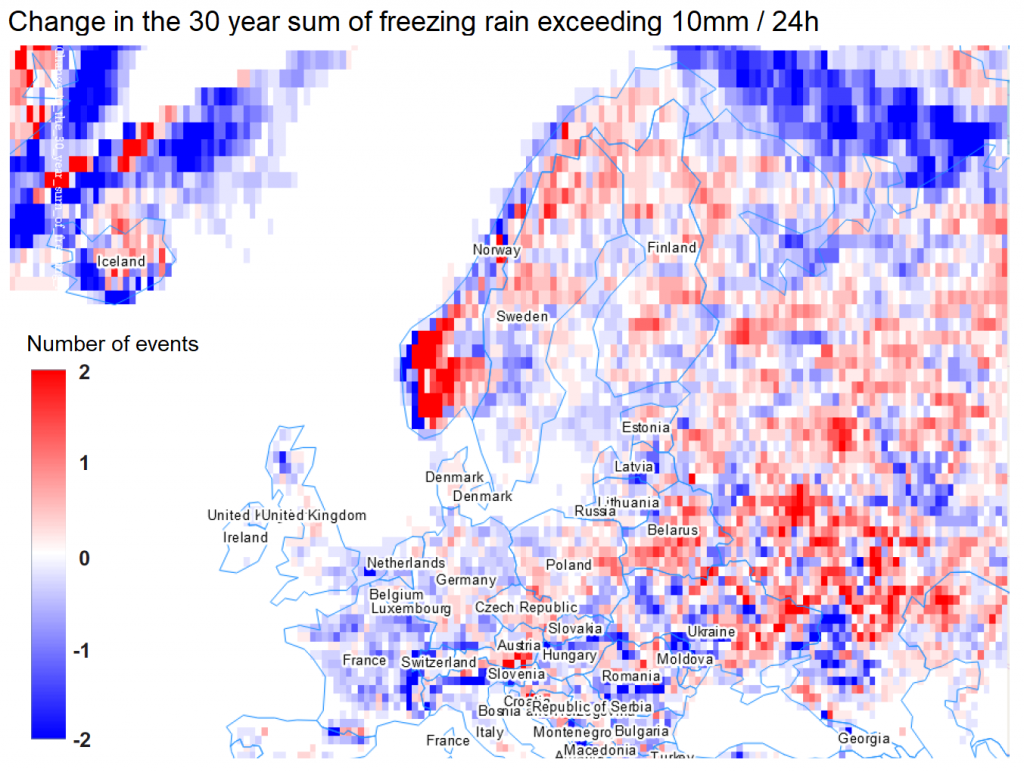A novel freezing rain impact indicator tailored for the European energy infrastructure was developed within the Copernicus Climate Change Service (C3S) CLIM4ENERGY project. The indicator is available for the users through the C3S Climate Data Store.
ANDREA VAJDA (1), OTTO HYVÄRINEN (1), MATTI KÄMÄRÄINEN (1), JUHA A. KARHU (1), PEKKA NIEMI (2), HILPPA GREGOW (1)
(1) Finnish Meteorological Institute, (2) Fingrid Oy
Freezing rain (FZRA) is one of the costliest high impact winter phenomena causing substantial damages to energy infrastructure due to the heavy ice accumulation. Energy companies require knowledge on the climate change impact on severe freezing rain to be able to increase the preparedness of energy infrastructure. Driven by this need, a pan-European freezing rain impact indicator tailored for the energy sector was developed in the C3S CLIM4ENERGY project during 2015–2017. The indicator was co-designed and tested together with the Finnish power transmission grid operator, Fingrid Oy. All the energy indicators developed in the project are now publicly available through a visualization tool (http://c4e-visu.ipsl.upmc.fr/), providing a variety of maps, data, documentation, product evaluation and fact sheets.
The occurrence of FZRA events were deduced from precipitation, temperature and relative humidity values by applying a freezing rain detection algorithm (Kämäräinen et al. 2016). The severity is given in two intensity categories: a) 10 mm/24 h is aimed at catching severe events that danger distribution lines and b) 25 mm/24 h is catching extreme events that start damaging more resistant transmission lines and transformer stations. ERA-Interim reanalysis data (Dee et al. 2011) and an ensemble of EURO-CORDEX regional climate models (Kotlarski et al., 2014) with medium (RCP4.5) and strong (RCP8.5) emission scenarios were used as input data. The indicator is presented through a set of frequency maps, a variety of statistical analyses and graphs, time series of occurrence of events, freezing rain amounts. Since prevailing wind conditions can intensify the damage caused by ice accumulation, information on wind speed during the FZRA events is also provided, as this was specifically desired by our co-designer, Fingrid.
The results indicate that severe FZRA is a relatively rare phenomenon over Europe. The occurrence of FZRA events with impact for distribution and transmission networks is highest in south-eastern Europe and the southern coast of Norway where over 20 cases with 10 mm/24h and locally up to 5 cases with 25 mm/24h have occurred during 1981-2010. Most of the severe cases observed in the present climate are short-lived, their length not exceeding one day. Climate projections predict a northward shift in the occurrence of severe FZRA cases in Fennoscandia and Russia by 2050. A slight decrease in the occurrence is projected over central Europe.
The developed freezing rain impact indicator was validated through multiple processes, including validation of the FZRA detection using ERA-Interim data against SYNOP observations and comparing distributions of FZRA amounts from ERA-Interim and RCMs. In addition, the most severe FZRA cases detected from ERA-Interim were also validated. The indicator allows both power distribution and transmission system operators to build resilience and develop prevention strategies for the safety of energy infrastructure in the future decades.

Acknowledgement: The study contributes to the C3S CLIM4ENERGY project funded by EC in the C3S program. We acknowledge the EURO-CORDEX dataset provided by SMHI, KNMI and GERICS.
References
Dee, D.P. et al., 2011: The ERA-Interim reanalysis: configuration and performance of the data assimilation system. Quart. J. Roy. Meteor. Soc., 137, 553–597.
Kotlarski, S., et al., 2014: Regional climate modeling on European scales: a joint standard evaluation of the EURO-CORDEX RCM ensemble. Geoscientific Model Development, 7, 1297–1333.
Kämäräinen, M. et al., 2016: A method to estimate freezing rain climatology from ERA-Interim reanalysis over Europe. Nat. Hazards Earth Syst. Sci.
HOW TO CITE THIS ARTICLE:
Vajda A., Hyvärinen O., Kämäräinen M., Karhu J. A., Niemi P., and Gregow H., 2019: A freezing rain impact indicator tailored for the European energy sector, FMI’s Climate Bulletin: Research Letters, 1(1), 12, DOI: 10.35614/ISSN-2341-6408-IK-2019-10-RL
CITATION INFORMATION:
Authors: Andrea Vajda, Otto Hyvärinen, Matti Kämäräinen, Juha A. Karhu, Pekka Niemi, and Hilppa Gregow
Received: March 28, 2019
Accepted: May 14, 2019
First online: June 19, 2019
Published: June 20, 2019
Journal: FMI’s Climate Bulletin: Research Letters
Volume: 1
Issue: 1
Page: 12
DOI: 10.35614/ISSN-2341-6408-IK-2019-10-RL
Header image: Eija Vallinheimo




